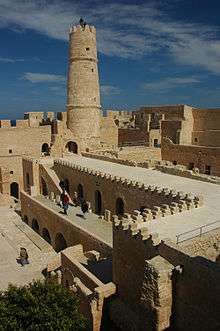Ribat
A ribat (Arabic: رباط; ribāṭ, hospice, hostel, base or retreat) is an Arabic term for a small fortification as built along a frontier during the first years of the Muslim conquest of North Africa to house military volunteers, called the murabitun. These fortifications later served to protect commercial routes, and as centers for isolated Muslim communities. Ribats were first seen in the 8th century. The word "ribat" in its abstract refers to voluntary defense of Islam which is why ribats were originally used to house those who fought to defend Islam in Jihad.[1] They can also be referred to by other names such as khanqah, most commonly used in Iran, and tekke, most commonly used in Turkey.[2]
Classically, ribat referred to the guard duty at a frontier outpost in order to defend dar al-Islam. The one who performs ribat is called murabit. Contemporary use of the term ribat is common among Islamic militant groups such as al-Qa'ida[3] or Islamic State of Iraq and the Levant.[4]
Ribat as a fortress

In time, ribats became hostels for voyagers on major trade routes (Caravanserai) and refuges for mystics. In this last sense, the ribat tradition was perhaps one of the early sources of the Sufi mystic brotherhoods, and a type of the later zaouia or Sufi lodge, which spread into North Africa and from there across the Sahara to West Africa. Here the homes of marabouts (religious teachers, usually Sufi) are termed ribats. Such places of spiritual retreat were termed Khanqah in Persian. Some important ribats to mention are the Ribat-i Malik (c.1068-80) which is located in the desert of central Asia and is still partially intact and the Ribat Sharaf from the 12th century which was built in a square shape with a monumental portal, a courtyard, and long vaulted rooms along the walls.[5] Most ribats had a similar architectural appearance which consisted of a surrounding wall with an entrance, living rooms, storehouses for provisions, a watch tower used to signal in the case of an invasion, four to eight towers, and a mosque in large ribats.[6]
Ribat in Sufism
Ribat was originally used as a term to describe a frontier post where travelers (particularly soldiers) could stay. The term transformed over time to become known as a center for Sufi fraternities. The ribats were converted to a peaceful use where Sufis could congregate.[7] Usually the ribats were inhabited by a Shaykha and his family and visitors were allowed to come and learn from him.[2] Many times the tomb of the founder was also located in the same building.[2] The institutionalization of these centers was made possible in part through donations from wealthy merchants, landowners, and powerful leaders.[8] Some of these compounds also received regular stipends to maintain them.[2] These institutions were used as a sort of school house where a Shaykha could teach his disciples the ways of the specific Sufi brotherhood or fraternity. They were also used as a place of worship where the Shaykha could observe the members of the specific Sufi order and help them on their Tariqa, or their inner path to Haqiqah, or ultimate truth "reality". Another use of ribat refers to a sort of Sufi convent for women, or a retreat house. Female shaykhas, scholars of law in medieval times, and large numbers of widows or divorcees lived in abstinence and worship in Sufi ribats.[9] Some of these women stayed in the ribats until they were able to remarry in an effort to maintain their reputation because divorced women were not widely accepted in Islamic society.
See also
References
| Wikimedia Commons has media related to Ribats. |
- ↑ Northedge, Alastair. "ʿAbbāsid art and architecture". Encyclopedia of Islam. 3.
- 1 2 3 4 Schimmel, Annemarie (1975). Mystical Dimensions of Islam. University of North Carolina Press. pp. 231–232. ISBN 0807812234.
- ↑ Long, Mark (Winter 2009). "Ribat, al-Qaeda, and the Challenge for US Foreign Policy". Middle East Journal. 63 (1): 31–47. doi:10.3751/63.1.12.
- ↑ http://fmso.leavenworth.army.mil/OEWatch/201503/201503.pdf
- ↑ Richard Ettinghausen; Oleg Grabar (1994). The Art and Architecture of Islam 650-1250. Yale University Press. pp. 277–278. ISBN 0300053304.
- ↑ Khalilieh, Hassan S. (1999). "The Ribât System and Its Role in Coastal Navigation". Journal of the Economic and Social History of the Orient. 42 (2): 212–225. doi:10.1163/1568520991446811.
- ↑ Hillenbrand, Robert (1994). Islamic Architecture: Form, Function and Meaning. New York: Columbia University Press. p. 331.
- ↑ Auer, Blain. "Futuh". Encyclopedia of Islam. 3.
- ↑ Hoffman, Valerie (1995). Sufism, Mystics, and Saints in Modern Egypt. Columbia, SC: University of South Carolina Press. p. 232. ISBN 978-1570038495.
- Cache of The Ribat by Hajj Ahmad Thomson, 23 06 2007.
- "The Ribats in Morocco and their influence in the spread of knowledge and tasawwuf" from: al-Imra'a al-Maghribiyya wa't-Tasawwuf (The Moroccan Woman and Tasawwuf in the Eleventh Century) by Mustafa 'Abdu's-Salam al-Mahmah)
- Ribat of Soussa, Muslim invention of rib vaulting? on muslimheritage.com, dated 23 February 2003.
- Majid Khadduri, War And Peace in the Law of Islam (Baltimore, Johns Hopkins University Press, 1955), ISBN 1-58477-695-1. p. 81.
- Hassan S. Khalilieh, "The Ribat System and Its Role in Coastal Navigation," Journal of the Economic and Social History of the Orient, 42,2 (1999), 212-225.
- Jörg Feuchter, "The Islamic Ribаt - A Model for the Christian Military Orders? Sacred Violence, Religious Concepts and the Invention of a Cultural Transfer," in Religion and Its Other: Secular and Sacral Concepts and Practices in Interaction. Edited by Heike Bock, Jörg Feuchter, and Michi Knecht (Frankfurt/M., Campus Verlag, 2008).